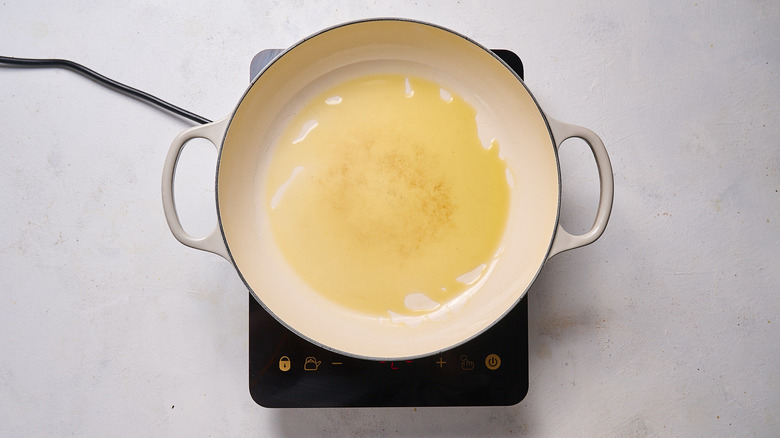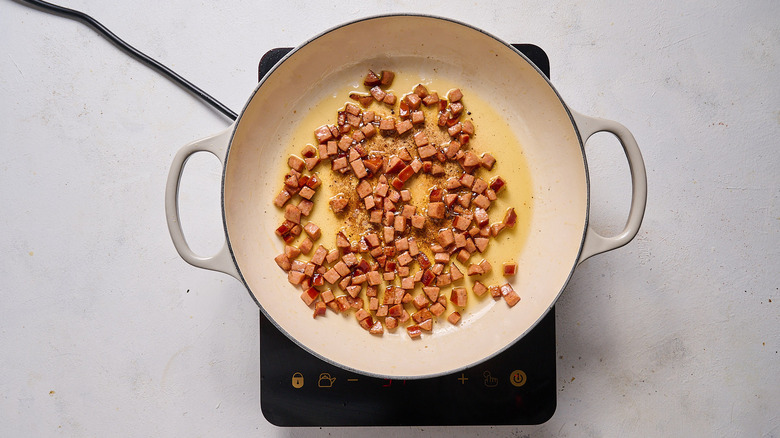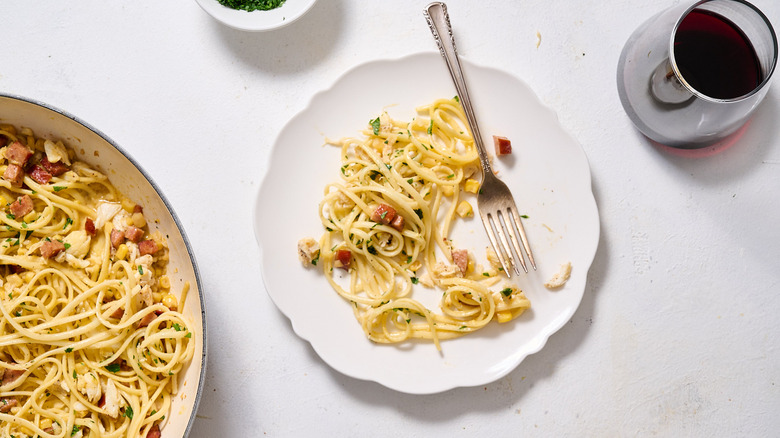Crab Boil Carbonara Recipe
Ask any Italian, and they'll tell you not to mess with classic pasta carbonara. Likely named after the coal miners who invented the dish, carbonara is, at its core, egg yolks, pecorino, black pepper, and guanciale. These were easy-to-find ingredients in Rome, where the dish was created, and the simple combination bred one of the city's most famous dishes. Despite what Italians may tell you, though, carbonara isn't only about the ingredients: It's also about how they are used. In the traditional technique, the pork is pan-fried, leaving flavor in the skillet that is absorbed by the pasta sauce, which later emulsifies with silky egg yolks and creamy cheese. Take this technique and switch up the ingredients, and you still have carbonara — but with a twist.
This recipe by Michelle McGlinn begins with spicy, salty Andouille sausage, sliced into small pieces to mimic the typical guanciale. This simple ingredient swap sets the tone for the rest of the Cajun-inspired dish: Joined by crab, corn, and Old Bay seasoning, classic carbonara turns into a spicy dish reminiscent of a crab boil. The usual suspects — egg yolks, cheese (in this case, Parmesan), and black pepper — are still star ingredients, swirled in at the last second for a creamy end result. It's not your typical carbonara, but based on how flavor-packed and lusciously creamy it is, it's unlikely to get any complaints.
Gather the ingredients for crab boil carbonara
The ingredients list for crab boil carbonara isn't too different from that of traditional carbonara, and you may already have many of the items at home. For starters, you'll need cracked black pepper, lemon juice, egg yolks, olive oil, and garlic. Because it's crab boil carbonara, you'll also need lump crab meat, Andouille sausage, corn kernels, Old Bay seasoning, and parsley. No need to overthink these ingredients: Canned crab and corn work well here. From there, you'll just need Parmesan and a long pasta like linguine — and as long as you salt the pasta water, you won't need any additional salt in this recipe.
Step 1: Season the crab
In a small bowl, combine crab meat, lemon juice, Old Bay seasoning, and black pepper. Set aside.
Step 2: Mix the egg yolks and Parmesan
In another bowl, whisk egg yolks and Parmesan until combined.
Step 3: Boil the pasta
Boil linguine in a pot of salted water until al dente.
Step 4: Save some pasta water
Reserve 1 cup cooking water before draining linguine.
Step 5: Heat up some oil
Meanwhile, add olive oil to a deep skillet and place over medium heat.
Step 6: Brown the sausage
Add Andouille pieces and cook, stirring occasionally, until very browned.
Step 7: Add garlic and corn
Add garlic and corn and cook until fragrant, about 1 minute.
Step 8: Toss in the linguine
Add cooked linguine and ½ cup pasta water, tossing to combine.
Step 9: Gradually add the egg mixture off the heat
Remove skillet from the heat and slowly add the egg mixture, tossing the pasta continuously, until silky.
Step 10: Stir in the crab
Return skillet to the heat and add crab mixture, tossing to combine. If needed, add the remaining pasta water to thin out the sauce.
Step 11: Serve
Top with chopped parsley and serve immediately.
How do I avoid scrambling the eggs in carbonara?
One of the most common mistakes in making carbonara is scrambling the eggs, which leads to a chunky, grainy sauce. The goal is to emulsify the fats in the eggs with the starches in the pasta water, not necessarily to cook the eggs. Eggs, as delicate as they are, are able to cook with residual heat alone, so the eggs in a successful carbonara aren't technically raw, either.
To get that perfect, silky in-between, you have to let the eggs cook only in residual heat. Whisk them with the cheese first so they're ready to go, then add them to the skillet of pasta only after removing the pan from the heat. This way, the eggs can interact with the pasta water without curdling from direct heat. Once the sauce comes together, you can throw it back onto the heat for a few minutes to warm the crab through.
This delicate cooking process raises the question: How can leftover carbonara be reheated? You'll notice that cold carbonara becomes granular, thanks to the fats solidifying in the sauce. This is tricky to undo without overcooking the eggs, but it can be done. The laziest (er, easiest) way to do this is in the microwave — just add a spoonful of water, stir, and reheat. The best way to reheat, though, is on the stovetop. Heat the pasta over low heat and toss with water, or add to a double boiler and toss until the emulsion softens back into a sauce.
What should you look for when buying crab meat?
When you walk into the store to buy the ingredients for this dish, you may be faced with more decisions than you expected. Crab meat is sold a dozen different ways. Most obviously, crabs can be bought fresh from the fishmonger, and you can steam, shell, and pick the meat out yourself to use for carbonara. This will be the freshest-tasting option, but it requires a lot of prep work.
An easier solution actually waits in the canned food aisle nestled between the tuna and sardines. Yep, canned crab is perfectly suitable to use in your cooking, especially in dishes with other strong flavors. Sold in the refrigerator, lump crab meat is steamed, processed, and packaged for using in dishes like this pasta carbonara. Because it's already cooked, you only have to warm it through. The refrigerated crab will be fresher and less salty than the canned version, but both are completely ready to use.
Next, you just have to choose a type of crab meat: Lump, white, or claw. If you can see the contents of the package, choose any variety of crab with large chunks and white meat. If you're choosing between cans, we recommend opting for lump crab meat, which will always have a good mild flavor, large chunks, and hardly any shells to pick through. One thing we don't recommend for this dish? Imitation crab meat — the flavor will be so noticeable that the cost savings won't be worthwhile.

- 12 ounces white or lump crab meat
- Juice from ½ lemon
- 1 teaspoon Old Bay seasoning
- ¼ teaspoon black pepper
- 6 egg yolks, beaten
- ½ cup grated Parmesan cheese
- ½ pound linguine pasta
- 2 tablespoons olive oil
- 6 ounces Andouille sausage, chopped into ¼-inch pieces
- 2 cloves garlic, minced
- 1 cup corn kernels
- ¼ cup finely chopped fresh parsley
- In a small bowl, combine crabmeat, lemon juice, Old Bay seasoning, and black pepper. Set aside.
- In another bowl, whisk egg yolks and Parmesan until combined.
- Boil linguine in a pot of salted water until al dente.
- Reserve 1 cup cooking water before draining linguine.
- Meanwhile, add olive oil to a deep skillet and place over medium heat.
- Add Andouille pieces and cook, stirring occasionally, until very browned.
- Add garlic and corn and cook until fragrant, about 1 minute.
- Add cooked linguine and ½ cup pasta water, tossing to combine.
- Remove skillet from the heat and slowly add the egg mixture, tossing the pasta continuously, until silky.
- Return skillet to the heat and add crab mixture, tossing to combine. If needed, add the remaining pasta water to thin out the sauce.
- Top with chopped parsley and serve immediately.
| Calories per Serving | 663 |
| Total Fat | 31.0 g |
| Saturated Fat | 10.2 g |
| Trans Fat | 0.0 g |
| Cholesterol | 338.0 mg |
| Total Carbohydrates | 55.9 g |
| Dietary Fiber | 3.3 g |
| Total Sugars | 3.1 g |
| Sodium | 1,102.9 mg |
| Protein | 39.2 g |















